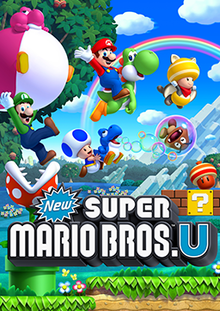Mario Kart is a series of kart racing games and a spin-off Mario franchise developed and published by Nintendo. Players compete in go-kart races while using various power-up items. It features characters and courses mostly from the Mario series as well as other gaming franchises such as The Legend of Zelda, Animal Crossing, F-Zero, Excitebike, and Splatoon.

Super Mario World, known in Japanese marketing as Super Mario World: Super Mario Bros. 4, is a platform video game developed by Nintendo EAD and published by Nintendo for the Super Nintendo Entertainment System (SNES). It was released in Japan in 1990, North America in 1991 and Europe and Australia in 1992. The player controls Mario on his quest to save Princess Peach and Dinosaur Land from the series' antagonist Bowser and the Koopalings. The gameplay is similar to that of earlier Super Mario games; players control Mario through a series of levels in which the goal is to reach the goalpost at the end.

Luigi is a fictional character featured in video games and related media released by Nintendo. Created by Japanese video game designer Shigeru Miyamoto, Luigi is portrayed as the younger fraternal twin brother and sidekick of Mario. Defined by his kind-hearted, yet cowardly demeanor, Luigi appears in many games throughout the Mario franchise, oftentimes accompanying his brother.

Super Mario Bros.: The Lost Levels is a 1986 Japanese platform video game developed by Nintendo R&D4 and published by Nintendo. It is a sequel to Super Mario Bros. (1985) and was originally released in Japan for the Family Computer Disk System as Super Mario Bros. 2 on June 3, 1986. Nintendo of America deemed it too difficult for its North American audience and instead released an alternative sequel, also titled Super Mario Bros. 2, in 1988. The game was renamed The Lost Levels and first released internationally in the 1993 Super Nintendo Entertainment System compilation Super Mario All-Stars. It was ported to the Game Boy Color, Game Boy Advance, Wii, Nintendo 3DS, Wii U and Nintendo Switch.
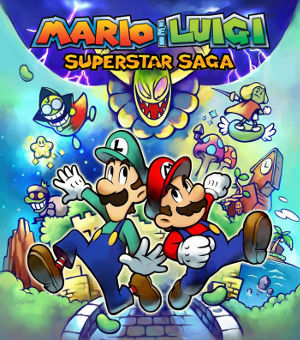
Mario & Luigi: Superstar Saga is a 2003 role-playing video game developed by AlphaDream and published by Nintendo for the Game Boy Advance. It was re-released for the Wii U's Virtual Console in 2014, Nintendo Switch Online Service in 2023, and remade for the Nintendo 3DS as Mario & Luigi: Superstar Saga + Bowser's Minions in 2017. In the game, Mario and Luigi travel to the Beanbean Kingdom in order to combat Cackletta and Fawful, who stole Princess Peach's voice for the purpose of harnessing the power of a special artifact called the Beanstar.

The Mario franchise is a video game series created by Nintendo. Nintendo is usually the developer and publisher of the franchise's games, but various games are developed by third-party companies, such as Hudson Soft and Intelligent Systems. Games in the Mario franchise primarily revolve around the protagonist Mario and often involve the trope of Bowser as the antagonist kidnapping Princess Peach, with Mario then rescuing her. Many characters have goals or plot arcs that vary between series; for example, the Luigi's Mansion games focus on Luigi ridding a haunted building of ghost-like creatures known as Boos, and Wario stars in games that center around his greed and desire for money and treasure.

Bowser Jr. is a fictional character who appears in Nintendo's Mario franchise as an antagonist. He is the son of the series' main antagonist, Bowser. Since his debut in Super Mario Sunshine in 2002, Bowser Jr. has been a recurring character in the Mario series and has been made playable in several spin-offs, such as Mario Superstar Baseball, Mario Strikers Charged, Super Smash Bros. for Nintendo 3DS and Wii U, and Super Smash Bros. Ultimate among many others. He often helps his father to kidnap Princess Peach and defeat Mario, but in the end wants nothing more than to impress his father. Bowser Jr.'s defining traits are his striking resemblance to his father, his energetic and driven personality, his expertise in mechanics and technology, his heavy uses of his Junior Clown Car and Magic Paintbrush, and the bib-like bandana he wears.
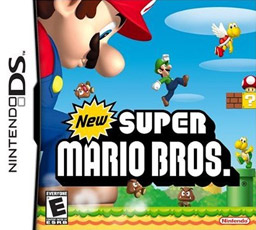
New Super Mario Bros. is a 2006 platform video game developed and published by Nintendo for the Nintendo DS. It was first released in May 2006 in North America and Japan, and in PAL regions in June 2006. It is the first installment in the New Super Mario Bros. subseries of the Super Mario franchise, and follows Mario as he fights his way through Bowser's henchmen to rescue Princess Peach. Mario has access to several old and new power-ups that help him complete his quest, including the Super Mushroom, the Fire Flower, and the Super Star, each giving him unique abilities. While traveling through eight worlds with more than 80 levels, Mario must defeat Bowser Jr. and Bowser before saving Princess Peach.

Super Mario is a platform game series created by Nintendo starring their mascot, Mario. It is the central series of the greater Mario franchise. At least one Super Mario game has been released for every major Nintendo video game console. However there have also been a number of Super Mario video games released on non-Nintendo gaming platforms. There are more than 20 games in the series.

Mario, or Super Mario, is a Japanese multimedia franchise created by Japanese game designer Shigeru Miyamoto for video game company Nintendo which produces and publishes its installments. Starring the titular Italian plumber Mario, it is primarily a video game franchise, but has extended to other forms of media, including television series, comic books, a 1993 feature film, a 2023 animated film and theme park attractions. The series' first installment was 1983's Mario Bros., although Mario had made his first appearance in 1981's arcade game Donkey Kong, and had already been featured in several games of the Donkey Kong and Game & Watch series. The Mario games have been developed by a wide variety of developers including Nintendo, Hudson Soft, and AlphaDream. Mario games have been released almost exclusively for Nintendo's various video game consoles and handhelds, from the third generation onward.

New Super Mario Bros. Wii is a platform video game developed and published by Nintendo for the Wii. A follow-up to New Super Mario Bros., it was first released in Australia, North America, and Europe in November 2009, followed by Japan a month later. A high-definition port for the Nvidia Shield TV was released in China in December 2017. Like other side-scrolling Super Mario games, the player controls Mario as he travels eight worlds and fights Bowser's henchmen to rescue Princess Peach. New Super Mario Bros. Wii was the first Super Mario game to feature simultaneous cooperative multiplayer gameplay; up to four people can play in cooperative and competitive multiplayer modes, taking control of Mario as well as Luigi and one of two multicolored Toads. The game also introduces "Super Guide", which allows the player to watch a computer-controlled character complete a level.

Toad, known in Japan as Kinopio, is a fictional character who primarily appears in Nintendo's Mario franchise. A humanoid with a mushroom-like head, Toad was created by Japanese video game designer Shigeru Miyamoto, and is portrayed as a citizen of the Mushroom Kingdom and is one of Princess Peach's most loyal attendants, constantly working on her behalf. Toad is usually seen as a non-player character who provides assistance to Mario and his friends in most games, but there are times when Toad takes center stage and appears as a protagonist, as seen in Super Mario Bros. 2, Wario's Woods and Super Mario 3D World.

New Super Mario Bros. 2 is a 2D side-scrolling platform video game in the New Super Mario Bros. series developed by Nintendo EAD Group No. 4 and published by Nintendo for its Nintendo 3DS handheld video game console, being released first in Japan on July 28, 2012. It is a direct sequel to the 2006 Nintendo DS game New Super Mario Bros. and is the first Nintendo-published game to be released simultaneously in both downloadable and physical forms.

Mario Kart 8 is a 2014 kart racing game developed and published by Nintendo for the Wii U. It retains the gameplay of previous games in the Mario Kart series, with players controlling a Mario franchise character in races around tracks. Tracks are themed around locales from the Super Mario platform series and are populated with power-ups that help players gain advantages in races. Different difficulties are selectable prior to a race; harder difficulties make gameplay faster. In the new anti-gravity sequences, players drive on walls and ceilings. Mario Kart 8 contains a variety of single-player and local and online multiplayer games modes, including Grand Prix racing and arena-based battle modes.
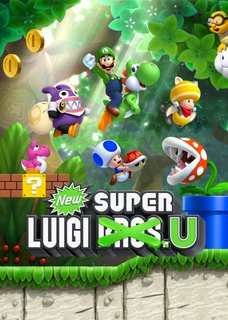
New Super Luigi U is a 2013 platform game developed by Nintendo for the Wii U. It is an expansion pack for New Super Mario Bros. U (2012), part of the Super Mario series. The plot and game mechanics remain identical to New Super Mario Bros. U, but Luigi replaces Mario as the protagonist. Luigi jumps higher and has less ground friction than Mario, and every level is redesigned to increase the difficulty level. The expansion adds Nabbit, a non-player character from New Super Mario Bros. U, as an invincible playable character.

Super Mario 3D World is a platform game developed and published by Nintendo for the Wii U in 2013. It is the sixth original 3D platform game in the Super Mario series and the sequel to Super Mario 3D Land (2011) for the Nintendo 3DS.
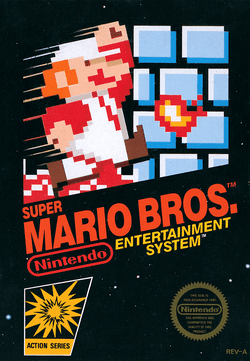
Super Mario Bros. is a 1985 platform game developed and published by Nintendo for the Nintendo Entertainment System (NES). The successor to the 1983 arcade game Mario Bros. and the first game in the Super Mario series, it was first released in 1985 for the Famicom in Japan. Following a limited US release for the NES, it was ported to international arcades for the Nintendo Vs. System in early 1986. The NES version received a wide release in North America that year and in PAL regions in 1987.
Paper Mario is a video game series and part of the Mario franchise, developed by Intelligent Systems and produced by Nintendo. It combines elements from the role-playing, action-adventure, and puzzle genres. Players control a paper cutout version of Mario, usually with allies, on a quest to defeat the antagonist, primarily Bowser. The series consists of six games and one spin-off; the first, Paper Mario (2000), was released for the Nintendo 64, and the most recent, Paper Mario: The Origami King (2020), for the Nintendo Switch.
